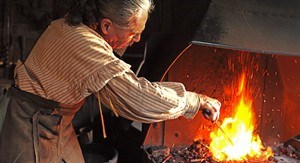
A Parks Canada Heritage Interpreter demonstrates blacksmithing at Fort Langley National Historic Site, in the Fraser Valley, B.C. in this undated handout photo. On any given day, visitors can step more than a century and a half back into the province's past, when the fur trade powered the economy, the Hudson's Bay Company was the governing authority, and the United States posed a serious military threat.THE CANADIAN PRESS/HO, Michael Boland/Parks Canada
April 22, 2014 - 6:00 AM
FORT LANGLEY, B.C. - Time travel isn't a far-out concept at Fort Langley National Historic Site in British Columbia's Fraser Valley.
On any given day, visitors can step more than a century and a half back into the province's past, when the fur trade powered the economy, the Hudson's Bay Company was the governing authority, and the United States posed a serious military threat.
Visitors stepping into this company fort, through timber palisade walls, will hear the clank of the blacksmith's mallet, the crack of musket fire and the crackle of the campfire.
This isn't any old pioneer village; it's 19th-century B.C. history brought to life, where interpreters wearing period costumes tell the stories of local First Nations, Scottish settlers, French-Canadian voyageurs and Metis children.
"It is the birthplace of British Columbia. It's the location where the province we live in started," said Nancy Hildebrand, a spokeswoman for Fort Langley National Historic Site.
"If this fort wasn't here we might be flying a different flag today. This might have ended up being part of the United States."
The fort, on the southern bank of the Fraser River and about 40 kilometres east of Vancouver, sits where the Hudson's Bay Company relocated its operations in 1839 to trade with First Nations.
An earlier fort was established in 1827 just four kilometres to the west but had to be moved because of the risk of flooding.
From the current location, the company collected furs for shipment to Europe, and prepared cranberries and fish for markets in California and Hawaii and produce for Russians in Alaska.
From the current spot, James Douglas, the first governor of British Columbia, proclaimed the Crown colony, securing the territory for Queen Victoria in the face of thousands of Americans seeking riches during the gold rush of 1858.
Hildebrand said some 30,000 gold miners passed through the fort where they were issued licences.
Visitors shouldn't be surprised that they, too, can pan for gold on the present-day site, not far from a store house that was built around 1839.
Hildebrand said about a dozen special events take place on the site during the year, but Parks Canada has added a few new activities.
She said starting May 3, visitors will be able to take guided audio tours of the fort in English, French, Mandarin, Japanese, German and Spanish.
They will also be able to register for two special campfire programs that start May 10 and focus on the voyageurs and the Royal Engineers, added Hildebrand.
Depending on the program, visitors will be able to make bannock, shoot an airsoft musket, dress in period pieces and, of course, sit around a campfire and listen to stories, she said.
Guests can also book an oTENTik. The five furnished luxury tent cabins are located within the fort and are decorated in special themes reflecting First Nations, French Canadian, gold miners and Scottish settlers. There's even a Hawaiian tent.
The tents were introduced last year, but Hildebrand said Parks Canada has redecorated them, adding power and Wi-Fi.
Once visitors have had their fill of the past, they can step back into the present by visiting the town of Fort Langley, located just outside the fort.
Deborah Kulchiski, a spokeswoman for Tourism Langley, said a unique experience awaits tourists in local antiques shops and artisan galleries and in the vineyards outside of the town.
"We've also become very well known as a destination for our wineries," she said. "We have six wineries within Langley.
"Our agri-tourism is probably one of our more sought-after activities in the region, especially in today's world where everyone is becoming more cautious of where their food is coming from."
It all adds up to make Langley and Fort Langley more than an area through which the Trans-Canada Highway runs.
"It's not just, you know, the No. 1 highway cutting through Langley," she said. "It's a really unique area to spend a weekend with the family or without."
———
If You Go...
For more information, visit http://www.pc.gc.ca/lhn-nhs/bc/langley/visit.aspx.
News from © The Canadian Press, 2014